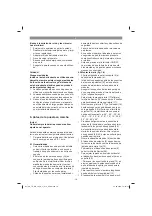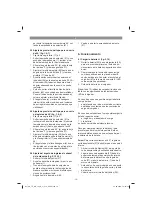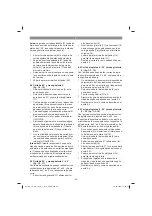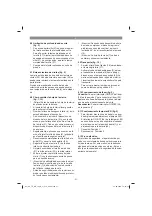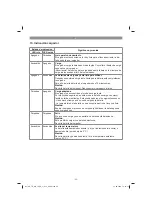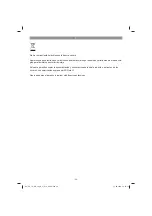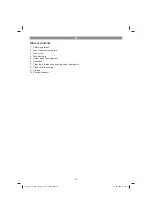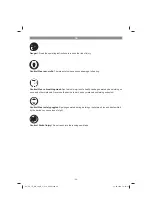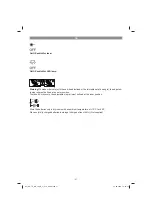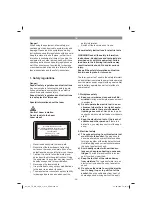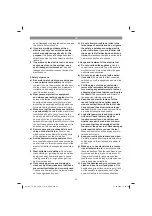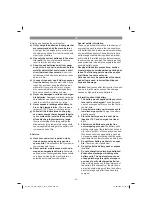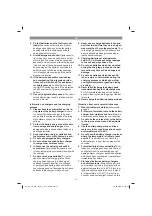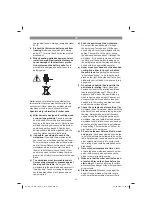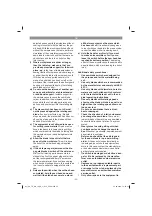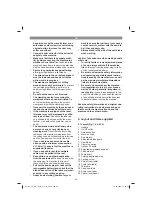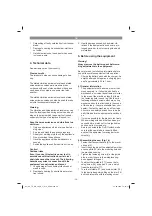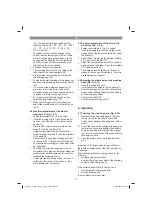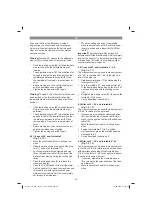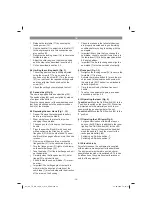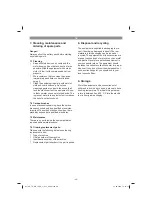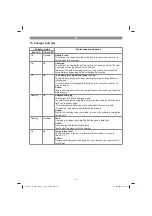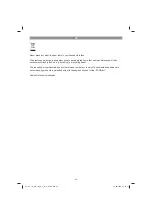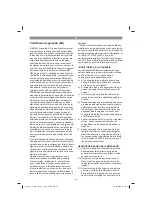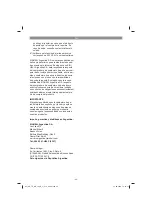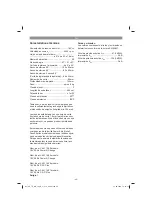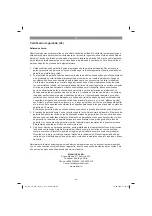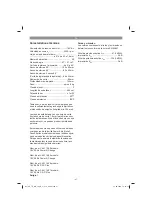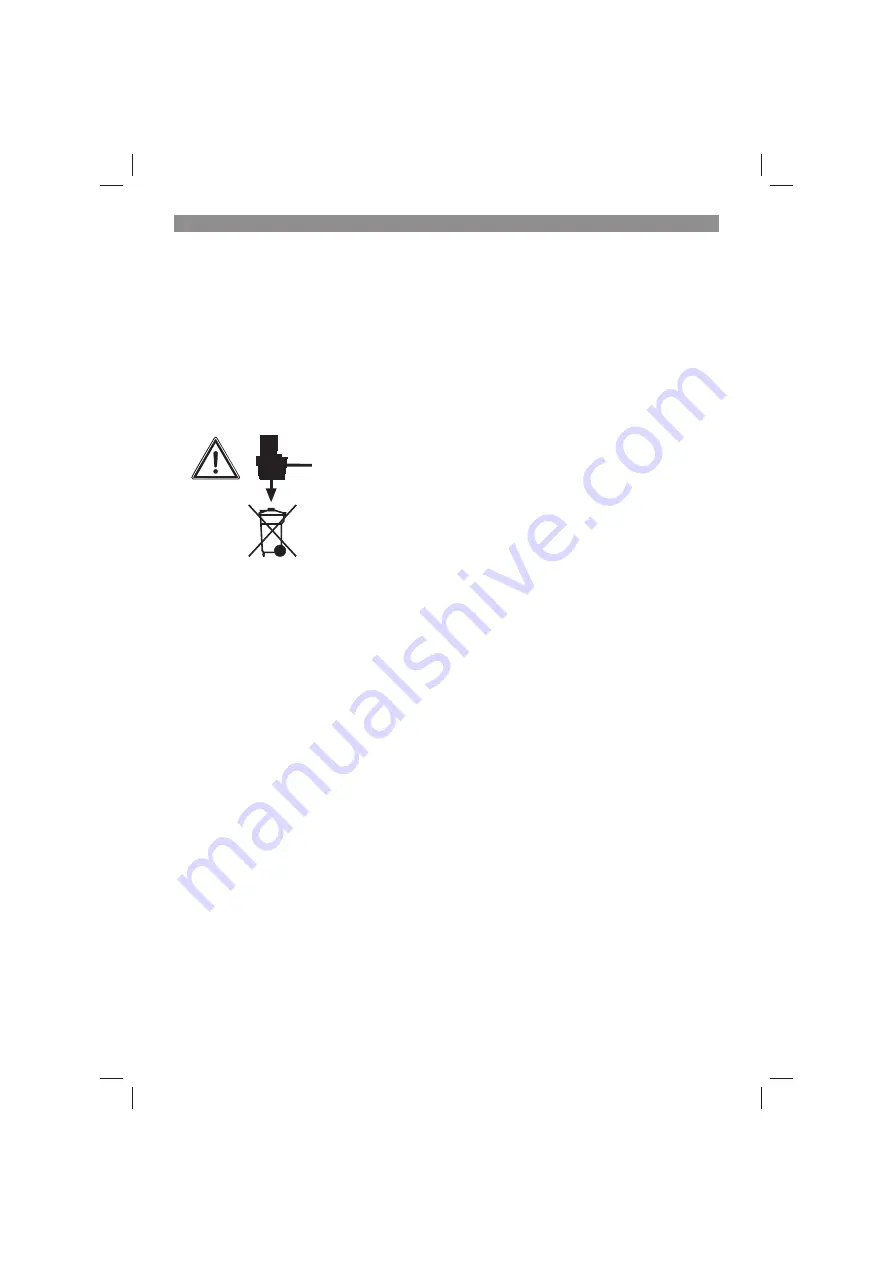
GB
- 32 -
charged batteries in storage (charged at least
40%).
8. Prevent the lithium-ion battery pack from
freezing.
Battery packs which were stored
below 0°C for more than 60 minutes must be
disposed of.
9. When handling batteries beware of elect-
rostatic charge: Electrostatic discharges
cause damage of the electronic protec-
tion system and the battery cells.
Avoid
electrostatic charging and never touch the
battery poles!
Batteries and cordless electric equipment con-
tain materials that are potentially harmful to the
environment. Never place any cordless electric
machines or tools in your household refuse.
Special safety information for miter saws
a) Miter saws are designed for cutting wood
or wood-type products.
They are not inten-
ded to be used for cutting ferrous materials
such as rods, bars, screws, etc. Abrasive dust
will lead to moving parts such as the bottom
guard hood getting blocked. Sparks from
cutting will burn the bottom guard hood, the
insertion plate and other plastic parts
b) If possible, use clamps to secure the
workpiece.
If you hold the workpiece with
your hand, you must keep your hand at least
100 mm away from each side of the saw bla-
de at all times. Never use this saw for cutting
workpieces which are too small, to clamp
them or to hold them with your hand. If your
hand is too close to the saw blade there is a
greater risk of injury from contact with the saw
blade.
c) The workpiece must immovable and eit-
her securely clamped or pressed against
the stop and the table.
Do not push the
workpiece into the saw blade and never cut it
“free-handed”. Loose or moving workpieces
could be catapulted out at high speed and
cause injuries.
d) Push the saw through the workpiece.
Do not pull the saw backwards through
the workpiece. To make a cut, lift the saw
head and pull it over the workpiece without
cutting. Then switch on the motor, swing
the saw head down and push it through the
workpiece. If it is pulled to make a cut there
is a danger of the saw blade leaping up on
the workpiece and the saw blade unit being
hurled with force against the operator.
e) Never cross your hand over the intended
cutting line, either in front of or behind
the saw blade.
Supporting the workpiece
“with crossed hands”, i.e. holding the work-
piece on the right-hand side next to the saw
blade with your left hand or vice versa is very
dangerous.
f) Do not reach behind the stop while the
saw blade is rotating.
Never place your
hands any closer to the rotating saw blade
than the safety distance of 100 mm (this
applies to both sides of the saw blade, e.g.
when removing wood scraps). You may not
necessarily be able to see how close your
hands are to the rotating saw blade and you
could sustain serious injuries.
g) Check the workpiece before cutting.
If the
workpiece is bent or warped, clamp it with the
side which is curved outward facing towards
the stop. Always make sure that there are
no gaps along the cutting line between the
workpiece, stop and table. Bent and warped
workpieces could twist or move position and
cause the rotating saw blade to get jammed
during cutting. There must be no nails or for-
eign bodies in the workpiece.
h) Do not use the saw before all tools, wood
scraps, etc.,
have been cleared from the tab-
le; only the workpiece is allowed to be on the
table. Small scraps, loose pieces of wood and
other objects which come into contact with
the rotating blade could be catapulted out at
high speed.
i) Only cut one workpiece at a time.
Stacks
of more than one workpiece cannot be clam-
ped or held properly and could cause the
blade to jam or slip while sawing.
j) Make sure that the miter saw is stood on
a level and
fi
rm work surface before you
start using it.
A level and
fi
rm work surface
will prevent any danger of the miter saw beco-
ming instable.
k) Plan your work.
Whenever you adjust the
angle of the saw blade or the miter angle,
make sure that adjustable stop is correctly
Anl_SA_TE_MS_18_20_Li_Solo_SPK8.indb 32
Anl_SA_TE_MS_18_20_Li_Solo_SPK8.indb 32
15.03.2018 14:19:54
15.03.2018 14:19:54

